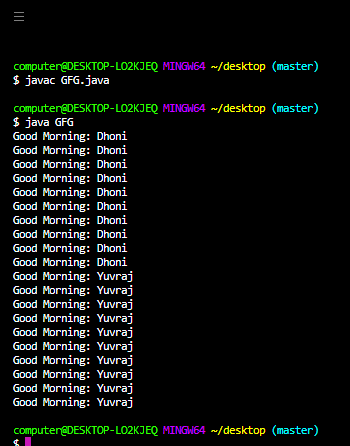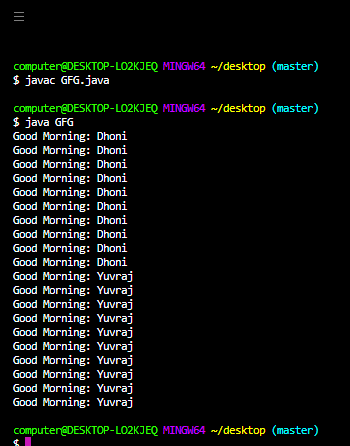Synchronized 是仅适用于方法和块而不适用于类和变量的修饰符。如果多个线程试图同时操作同一个Java对象,那么可能会出现数据不一致问题来解决这个问题,我们应该使用“ synchronized ”关键字。如果一个方法或块声明为同步的,那么一次只允许一个线程在给定的对象上执行该方法或块,以便解决数据不一致问题。内部同步的概念是通过使用锁来实现的。 Java中的每个对象都有一个唯一的锁。每当我们使用’ synchronized ‘关键字时,只有锁的概念才会出现。
如果一个线程想要先在给定的对象上执行同步方法,它必须在线程获得锁后获得该对象的锁,然后才允许在该对象上执行任何同步方法。内部获取和释放锁由 JVM 负责,程序员不负责此活动。当线程在给定对象上执行同步方法时,其余线程不允许在同一对象上同时执行任何同步方法。但允许剩余线程同时执行非同步方法。
对象级锁就是在Java中每个对象都有一个独特的锁,不过对象的机制–级锁。如果一个线程想要在给定的对象上执行同步方法,那么一旦线程获得对象级锁,线程首先需要对象级锁,然后允许在给定对象上执行任何同步方法,一旦方法执行完成自动线程释放该对象的锁。
例子:
Java
// Java program to illustrate Object Level Lock Concept
// Import required packages
import java.io.*;
import java.util.*;
// Class 1
// Helper Class 1
// Consists of synchronized method wish
class Display {
// Declaring Non-static wish method
public void wish(String name)
{
// synchronizing wish method
// and getting the lock of current object
synchronized (this)
{
for (int i = 1; i <= 10; i++) {
// display message only
System.out.print("Good Morning: ");
// Try block to check. for exceptions
try {
// Putting thread on sleep for specified
// time
// usig the sleep() method
Thread.sleep(1000);
}
// Catch block to handle the exceptions
catch (InterruptedException e) {
// Print the occurred exception/s
System.out.println(e);
}
// Display message only
System.out.println(name);
}
}
}
}
// Class 2
// Helper Class 2 (extending main Thread Class)
// myThread with override the run method and
// consists of parameterized constructor
class myThread extends Thread {
// member variable of this class
Display d;
String name;
// Constructor(Parameterized) of this class
myThread(Display d, String name)
{
// this keyword refers to currrent object itself
this.d = d;
this.name = name;
}
// run() method for thread
public void run()
{
// Calling wish method of display class
d.wish(name);
}
}
// Class 3
// Main Class
class GFG {
// Main driver method
public static void main(String[] args)
{
// Creating display class(Class 1) object
// in the main() method
Display d = new Display();
// Creating thread objects in main method()
myThread t1 = new myThread(d, "Dhoni");
myThread t2 = new myThread(d, "Yuvraj");
// Starting the threads using the start() method
t1.start();
t2.start();
}
}Java
// java program to illustrate Class Level Lock Concept
// Importing required packages
import java.io.*;
import java.util.*;
// Class 1
// Helper Class
// Consist of synchronized method wish
class Display {
// Declaring static wish method
public static void wish(String name)
{
// synchronizing wish method
// and getting the lock of display class
synchronized (Display.class)
{
for (int i = 1; i <= 10; i++) {
// Display message only
System.out.print("Good Morning: ");
// Try block to check for exceptions
try {
// Putting thread on sleep for specified
// time
// using the sleep() method
Thread.sleep(1000);
}
// Catch block to handle the exception
catch (InterruptedException e) {
// Throwing exception
System.out.println(e);
}
// Display message
System.out.println(name);
}
}
}
}
// C;asss 2
// Helper Class (extends the Thread class)
// myThread with override the run method
// as per our requirements it also consists
// of parameterised constructor
class myThread extends Thread {
// Member variables of this class
Display d;
String name;
// Constructor of this class
myThread(Display d, String name)
{
// This keyword refers to current object itself
this.d = d;
this.name = name;
}
// run method for thread/s
public void run()
{
// Calling wish method of display class
d.wish(name);
}
}
// Class 3
// Main Class
class GFG {
// Main driver method
public static void main(String[] args)
{
// Creating Display class(Class 1) object
// in the main() method
Display d = new Display();
// Creating a thread objects
myThread t1 = new myThread(d, "Dhoni");
myThread t2 = new myThread(d, "Yuvraj");
// Starting the threads using start() method
t1.start();
t2.start();
}
}
类级锁是一种机制,其中Java中的每个类都有一个唯一的锁,它只不过是一个类级锁。如果线程想要执行静态同步方法,那么一旦线程获得类级锁,则该线程需要类级锁,则允许执行该类的任何静态同步方法。一旦方法执行完成,线程就会自动释放锁。当线程执行静态同步方法时,其余线程不允许同时执行该类的任何静态同步方法。
例子:
Java
// java program to illustrate Class Level Lock Concept
// Importing required packages
import java.io.*;
import java.util.*;
// Class 1
// Helper Class
// Consist of synchronized method wish
class Display {
// Declaring static wish method
public static void wish(String name)
{
// synchronizing wish method
// and getting the lock of display class
synchronized (Display.class)
{
for (int i = 1; i <= 10; i++) {
// Display message only
System.out.print("Good Morning: ");
// Try block to check for exceptions
try {
// Putting thread on sleep for specified
// time
// using the sleep() method
Thread.sleep(1000);
}
// Catch block to handle the exception
catch (InterruptedException e) {
// Throwing exception
System.out.println(e);
}
// Display message
System.out.println(name);
}
}
}
}
// C;asss 2
// Helper Class (extends the Thread class)
// myThread with override the run method
// as per our requirements it also consists
// of parameterised constructor
class myThread extends Thread {
// Member variables of this class
Display d;
String name;
// Constructor of this class
myThread(Display d, String name)
{
// This keyword refers to current object itself
this.d = d;
this.name = name;
}
// run method for thread/s
public void run()
{
// Calling wish method of display class
d.wish(name);
}
}
// Class 3
// Main Class
class GFG {
// Main driver method
public static void main(String[] args)
{
// Creating Display class(Class 1) object
// in the main() method
Display d = new Display();
// Creating a thread objects
myThread t1 = new myThread(d, "Dhoni");
myThread t2 = new myThread(d, "Yuvraj");
// Starting the threads using start() method
t1.start();
t2.start();
}
}

|
Class Level Lock |
Object Level Lock |
|---|---|
| This lock can be used when we want to prevent multiple threads to enter the synchronized block of available instances on runtime. | This lock is used when we want a non-static method or non-static block of our code should be accessed by only one thread at a time. |
| This lock is used to make static data thread-safe. | This lock is used to make non-static data thread-safe. |
| Multiple objects of a particular class may exist but there is always one class’s class object lock available. | Every object the class have their own lock. |
|
We can get a class level lock as follows: public class GFG { public void m1( ) { synchronized (GFG.class) { // some line of code } } |
We can get object level lock as follows: public class GFG { public void m1( ) { synchronized (this) { // some line of code } } } |